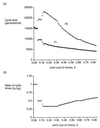Runaway ornament diversity caused by Fisherian sexual selection
- PMID: 9560236
- PMCID: PMC20221
- DOI: 10.1073/pnas.95.9.5106
Runaway ornament diversity caused by Fisherian sexual selection
Abstract
Fisher's runaway process of sexual selection is potentially an important force generating character divergence between closely related populations. We investigated the evolution of multiple female preferences by Fisher's runaway process. There are two outcomes of runaway. The first is the evolution of mate preference to a stable equilibrium. This evolution occurs if the benefits of mate choice are sufficiently large relative to the cost of choice. Alternatively, mate preferences evolve cyclically. The rate and pattern of cyclic evolution depends primarily on the individual cost of choice and epistasis in the joint cost of choice. If there are small differences in natural selection (e.g., predation risk) between populations, cyclic evolution quickly leads to divergence in mate preferences and sexual ornaments and so to sexual isolation.
Figures




References
-
- Darwin C R. The Descent of Man and Selection in Relation to Sex. London: John Murray; 1871.
-
- Andersson M. Sexual Selection. Princeton: Princeton Univ. Press; 1994.
-
- Fryer G, Iles T D. The Cichlid Fishes of the Great Lakes of Africa. Edinburgh: Oliver & Boyd; 1980.
-
- Carson H L. In: Evolutionary Processes and Theory. Karlin S, Nevo E, editors. Orlando, FL: Academic; 1986. pp. 391–409.
-
- Eberhard W G. Sexual Selection and Animal Genitalia. Cambridge, MA: Harvard Univ. Press; 1985.
Publication types
MeSH terms
LinkOut - more resources
Full Text Sources

